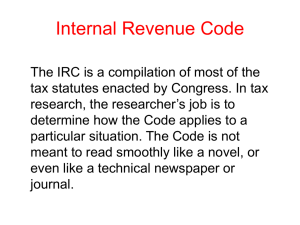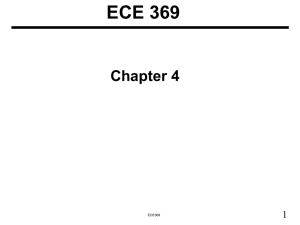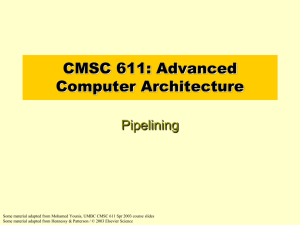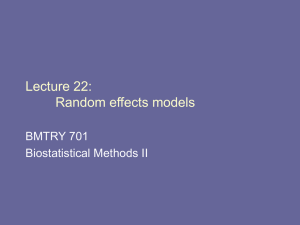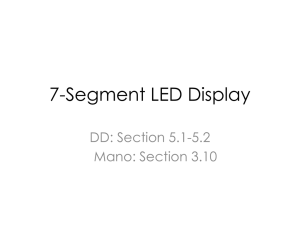ppt - Computer Science Department
advertisement
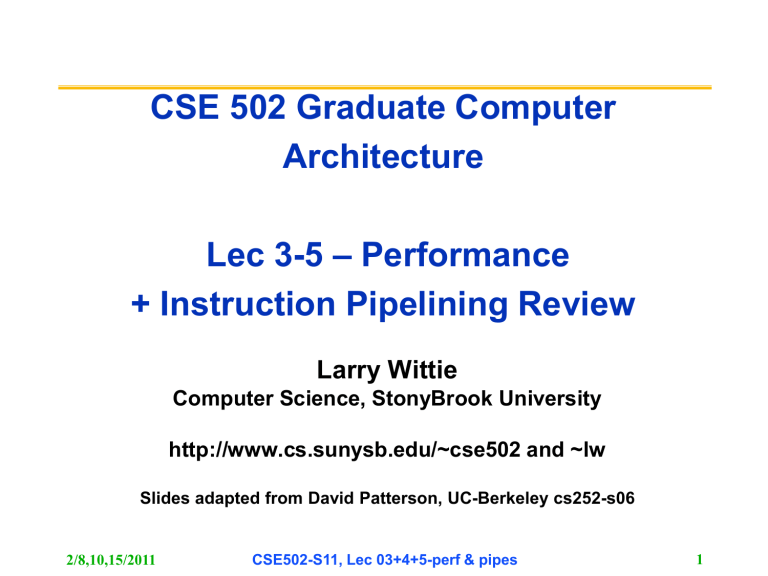
CSE 502 Graduate Computer
Architecture
Lec 3-5 – Performance
+ Instruction Pipelining Review
Larry Wittie
Computer Science, StonyBrook University
http://www.cs.sunysb.edu/~cse502 and ~lw
Slides adapted from David Patterson, UC-Berkeley cs252-s06
2/8,10,15/2011
CSE502-S11, Lec 03+4+5-perf & pipes
1
Review from last lecture
• Tracking and extrapolating technology part of
architect’s responsibility
• Expect Bandwidth in disks, DRAM, network, and
processors to improve by at least as much as the
square of the improvement in Latency
• Quantify Cost (vs. Price)
– IC f(Area2) + Learning curve, volume, commodity, price margins
• Quantify dynamic and static power
– Capacitance x Voltage2 x frequency, Energy vs. power
• Quantify dependability
– Reliability (MTTF vs. FIT), Availability (MTTF/(MTTF+MTTR)
2/8,10,15/2011
CSE502-S11, Lec 03+4+5-perf & pipes
2
Outline
•
•
•
•
•
•
•
•
•
•
Review
F&P: Benchmarks age, disks fail, singlepoint fail
danger
502 Administrivia
MIPS – An ISA for Pipelining
5 stage pipelining
Structural and Data Hazards
Forwarding
Branch Schemes
Exceptions and Interrupts
Conclusion
2/8,10,15/2011
CSE502-S11, Lec 03+4+5-perf & pipes
3
Fallacies and Pitfalls (1/2)
• Fallacies - commonly held misconceptions
– When discussing a fallacy, we try to give a counterexample.
• Pitfalls - easily made mistakes.
– Often generalizations of principles true in limited context
– Text shows Fallacies and Pitfalls to help you avoid these errors
• Fallacy: Benchmarks remain valid indefinitely
– Once a benchmark becomes popular, there is tremendous
pressure to improve performance by targeted optimizations or
by aggressive interpretation of the rules for running the
benchmark: “benchmarksmanship.”
– 70 benchmarks in the 5 SPEC releases to 2000. 70% dropped
from the next release because no longer useful
• Pitfall: A single point of failure
– Rule of thumb for fault tolerant systems: make sure
that every component is redundant so that no single
component failure can bring down the whole system
(e.g, power supply)
Lab rule of thumb: “Don’t buy one of anything.”
2/8,10,15/2011
CSE502-S11, Lec 03+4+5-perf & pipes
4
Fallacies and Pitfalls (2/2)
• Fallacy - Rated MTTF of disks is 1,200,000 hours or
140 years, so disks practically never fail
• But disk lifetime is 5 years replace a disk every 5
years; on average, 28 replacements, so “never” fail
• A better unit: % that fail (1.2M MTTF = 833 FIT)
• Fail over lifetime: if had 1000 disks for 5 years
= 1000*(5*365*24)*833 /109 = 36,485,000 / 106 = 37
= 3.7% (37/1000) fail over 5 yr lifetime (1.2M hr MTTF)
• But this is under pristine conditions
– little vibration, narrow temperature range no power failures
• Real world: 3% to 6% of SCSI drives fail per year
– 3400 - 6800 FIT or 150,000 to 300,000 hour MTTF [Gray & van Ingen 05]
• 3% to 7% of ATA drives fail per year
(Advanced Tech Attachment)
– 3400 - 8000 FIT or 125,000 to 300,000 hour MTTF [Gray & van Ingen 05]
2/8,10,15/2011
CSE502-S11, Lec 03+4+5-perf & pipes
5
CSE502: Administrivia
Instructor: Prof Larry Wittie
Office/Lab: 1308 CompSci, lw AT icDOTsunysbDOTedu
Office Hrs: TuTh, 3:45 - 5:15 pm, if door open, or appt.
T. A.: Unlikely
Class:
TuTh, 2:20 - 3:40 pm
2120 Comp Sci
Text:
Computer Architecture: A Quantitative
Approach, 4th Ed. (Oct, 2006), ISBN 0123704901 or
978-0123704900, $65/($50?) Amazon; $77used SBU, S11
Web page: http://www.cs.sunysb.edu/~cse502/
Current reading: Appendix A (back of CAQA4)
(Chap 1 was last week)
(New edition this fall 2011 so little 4ed trade-back value)
2/8,10,15/2011
CSE502-S11, Lec 03+4+5-perf & pipes
6
Outline
•
•
•
•
•
•
•
•
•
•
Review
F&P: Benchmarks age, disks fail, single-points fail
502 Administrivia
MIPS – An ISA for Pipelining
5 stage pipelining
Structural and Data Hazards
Forwarding
Branch Schemes
Exceptions and Interrupts
Conclusion
2/8,10,15/2011
CSE502-S11, Lec 03+4+5-perf & pipes
7
A "Typical" RISC ISA
•
•
•
•
32-bit fixed format instruction (only 3 formats: RIJ)
32 32-bit GPR (R0 contains zero, DP takes pair)
3-address, reg-reg arithmetic instruction
Single address mode for load/store:
base + displacement
– no indirection (since it needs another memory access)
• Simple branch conditions (e.g., single-bit: 0 or not?)
• (Delayed branch - ineffective in deep pipelines, so
no longer used)
see: SPARC, MIPS, HP PA-Risc, DEC Alpha, IBM PowerPC,
CDC 6600, CDC 7600, Cray-1, Cray-2, Cray-3
2/8,10,15/2011
CSE502-S11, Lec 03+4+5-perf & pipes
8
Example: MIPS
Register-Register – R Format – Arithmetic operations
31
26 25
Op
21 20
Rs1
16 15
Rs2
11 10
6 5
Rd
0
Opx
Register-Immediate – I Format – All immediate arithmetic ops
31
26 25
Op
21 20
Rs1
16 15
Rd
immediate
0
Branch – I Format – Moderate relative distance conditional branches
31
26 25
Op
Rs1
21 20
16 15
Rs2/Opx
immediate
Jump / Call – J Format – Long distance jumps
31
26 25
Op
2/8,10,15/2011
target
CSE502-S11, Lec 03+4+5-perf & pipes
0
0
9
Datapath vs Control
Datapath
Controller
signals
Control Points
• Datapath: Storage, Functional Units, Interconnections sufficient to
perform the desired functions
– Inputs are Control Points
– Outputs are signals
• Controller: State machine to orchestrate operation on the data path
– Based on desired function and signals
2/8,10,15/2011
CSE502-S11, Lec 03+4+5-perf & pipes
10
Approaching an ISA
• Instruction Set Architecture
– Defines set of operations, instruction format, hardware supported data
types, named storage, addressing modes, sequencing
• Meaning of each instruction is described by RTL (register
transfer language) on architected registers and memory
• Given technology constraints, assemble adequate datapath
– Architected storage mapped to actual storage
– Function Units (FUs) to do all the required operations
– Possible additional storage (eg. Internal registers: MAR, MDR, IR,
…{Memory Address Register, Memory Data Register, Instruction
Register}
– Interconnect to move information among registers and function units
• Map each instruction to a sequence of RTL operations
• Collate sequences into symbolic controller state transition
diagram (STD)
• Lower symbolic STD to control points
• Implement controller
2/8,10,15/2011
CSE502-S11, Lec 03+4+5-perf & pipes
11
5 Steps of a (pre-pipelined) MIPS Datapath
Figure A.2, Page A-8
Stages: 1
Instruction
Fetch
2
Instr. Decode
Reg. Fetch
3
Execute
Addr. Calc
Next SEQ PC
Adder
PC
4
RS2
L
M
D
MUX
Data
Memory
Imm
ALU
RD
MUX MUX
RTL Actions: Reg.
Transfer Language
Zero?
RS1
Reg File
Inst
Memory
Address
IR
5
Write
Back
MUX
Next PC
4
Memory
Access
Sign
Extend
IR <= mem[PC]; #stage 1
PC <= PC + 4
Reg[IRrd] <=
WB Data
(Reg[Irrs]
2/8,10,15/2011
opIRop Reg[IRrt])
#op is done in stages 2-5
CSE502-S11, Lec 03+4+5-perf & pipes
12
5-Stage MIPS Datapath(has pipeline latches)
2
Instr. Decode
Reg. Fetch
Next SEQ PC
Next SEQ PC
Adder
4
MUX
MEM/WB
Data
Memory
EX/MEM
Imm
ALU
#2
MUX MUX
A <= Reg[IRrs];
B <= Reg[IRrt]
ID/EX
#1
Reg File
IF/ID
Memory
Address
IR <= mem[PC];
PC <= PC + 4
5
Write
Back
Zero?
RS1
RS2
4
Memory
Access
MUX
Next PC
3
Execute
Addr. Calc
WB Data
Figure A.3, Page A-9
Stages: 1
Instruction
Fetch
Sign
Extend
RD
RD
RD
rslt <= A opIRop B
#3
WB <= rslt
Reg[IRrd] <= WB
2/8,10,15/2011
#4
#5
CSE502-S11, Lec 03+4+5-perf & pipes
13
Instruction Set Processor Controller
IR <= mem[PC];
PC <= PC + 4
JAL
A <= Reg[IRrs];
JR
RR
if bop(A,B)
opFetch-DeCoDe
ST
B <= Reg[IRrt]
jmp
br
Ifetch
PC <= IRjaddr
r <= A opIRop B
RI
LD
r <= A opIRop IRim
r <= A + IRim
WB <= r
WB <= Mem[r]
PC <= PC+IRim
WB <= r
Reg[IRrd] <= WB
2/8,10,15/2011
Reg[IRrd] <= WB
CSE502-S11, Lec 03+4+5-perf & pipes
Reg[IRrd] <= WB
14
5-Stage MIPS Datapath(has pipeline latches)
2
Instr. Decode
Reg. Fetch
Next SEQ PC
Next SEQ PC
Adder
4
MUX
MEM/WB
Data
Memory
EX/MEM
ALU
MUX MUX
ID/EX
Reg File
IF/ID
Memory
Address
Imm
5
Write
Back
Zero?
RS1
RS2
4
Memory
Access
MUX
Next PC
3
Execute
Addr. Calc
WB Data
Figure A.3, Page A-9
Stages: 1
Instruction
Fetch
Sign
Extend
RD
RD
RD
• Data stationary control
– local decode for each instruction phase / pipeline stage
2/8,10,15/2011
CSE502-S11, Lec 03+4+5-perf & pipes
15
Visualizing Pipelining
Figure A.2, Page A-8
Time (clock cycles)
2/8,10,15/2011
DMem
Ifetch
Reg
DMem
Reg
DMem
Reg
ALU
O
r
d
e
r
Reg
ALU
Ifetch
ALU
I
n
s
t
r.
ALU
Cycle 1 Cycle 2 Cycle 3 Cycle 4 Cycle 5 Cycle 6 Cycle 7
Ifetch
Ifetch
Reg
Reg
CSE502-S11, Lec 03+4+5-perf & pipes
Reg
DMem
Reg
16
Pipelining is not quite that easy!
• Limits to pipelining: Hazards prevent next instruction
from executing during its designated clock cycle
– Structural hazards: HW cannot support this combination of instructions
(having a single person to fold and put clothes away at same time)
– Data hazards: Instruction depends on result of prior instruction still in
the pipeline (having a missing sock in a later wash; cannot put away)
– Control hazards: Caused by delay between the fetching of instructions
and decisions about changes in control flow (branches and jumps).
2/8,10,15/2011
CSE502-S11, Lec 03+4+5-perf & pipes
17
One Memory_Port / Structural_Hazards
Figure A.4, Page A-14
Time (clock cycles)
2/8,10,15/2011
Reg
DMem
Reg
DMem
Reg
DMem
Reg
ALU
Instr 4
Ifetch
ALU
Instr 3
DMem
ALU
O
r
d
e
r
Instr 2
Reg
ALU
I Load Ifetch
n
s
Instr 1
t
r.
ALU
Cycle 1 Cycle 2 Cycle 3 Cycle 4 Cycle 5 Cycle 6 Cycle 7
Ifetch
Ifetch
Reg
Ifetch
Reg
CSE502-S11, Lec 03+4+5-perf & pipes
Reg
Reg
Reg
DMem
18
One Memory Port/Structural Hazards
(Similar to Figure A.5, Page A-15)
Time (clock cycles)
Stall
DMem
Ifetch
Reg
DMem
Reg
ALU
Ifetch
Bubble
Instr 3
Reg
Reg
DMem
Bubble Bubble
Ifetch
Reg
Reg
Bubble
ALU
O
r
d
e
r
Instr 2
Reg
ALU
I Load Ifetch
n
s
Instr 1
t
r.
ALU
Cycle 1 Cycle 2 Cycle 3 Cycle 4 Cycle 5 Cycle 6 Cycle 7
Bubble
Reg
DMem
How do you “bubble” the pipe?
2/8,10,15/2011
CSE502-S11, Lec 03+4+5-perf & pipes
19
Code SpeedUp Equation for Pipelining
CPIpipelined Ideal CPI Average Stall cycles per Inst
Cycle Time unpipelined
Ideal CPI Pipeline depth
Speedup
Ideal CPI Pipeline stall CPI
Cycle Timepipelined
For simple RISC pipeline, Ideal CPI = 1:
Cycle Timeunpipelined
Pipeline depth
Speedup
1 Pipeline stall CPI
Cycle Timepipelined
2/8,10,15/2011
CSE502-S11, Lec 03+4+5-perf & pipes
20
Example: Dual-port vs. Single-port
• Machine A: Dual ported memory (“Harvard Architecture”)
• Machine B: Single ported memory, but its pipelined
implementation has a 1.05 times faster clock rate
• Ideal CPI = 1 for both
• Assume loads are 20% of instructions executed
SpeedUpA = Pipeline Depth/(1 + 0) x (clockunpipe/clockpipe)
= Pipeline Depth
SpeedUpB = Pipeline Depth/(1 + 0.2 x 1) x (clockunpipe/(clockunpipe / 1.05)
= (Pipeline Depth/1.20) x 1.05
{105/120 = 7/8}
= 0.875 x Pipeline Depth
SpeedUpA / SpeedUpB = Pipeline Depth/(0.875 x Pipeline Depth) = 1.14
• Machine A is 1.14 times faster
2/8,10,15/2011
CSE502-S11, Lec 03+4+5-perf & pipes
21
Data Hazard on Register R1 (If No Forwarding)
Figure A.6, Page A-16
Time (clock cycles)
and r6,r1,r7
or
r8,r1,r9
xor r10,r1,r11
2/8,10,15/2011
Ifetch
DMem
Reg
DMem
Ifetch
Reg
DMem
Ifetch
Reg
DMem
Ifetch
Reg
ALU
sub r4,r1,r3
Reg
ALU
Ifetch
ALU
O
r
d
e
r
add r1,r2,r3
No forwarding
needed since
write reg in 1st half
cycle, read reg in
2nd half cycle.
WB
ALU
I
n
s
t
r.
MEM
ALU
IF ID/RF EX
Reg
CSE502-S11, Lec 03+4+5-perf & pipes
Reg
Reg
Reg
DMem
22
Reg
Three Generic Data Hazards
• Read After Write (RAW)
InstrJ tries to read operand before InstrI writes it
I: add r1,r2,r3
J: sub r4,r1,r3
• Caused by a “(True) Dependence” (in compiler
nomenclature). This hazard results from an actual
need for communicating a new data value.
2/8,10,15/2011
CSE502-S11, Lec 03+4+5-perf & pipes
23
Three Generic Data Hazards
• Write After Read (WAR)
InstrJ writes operand before InstrI reads it
I: sub r4,r1,r3
J: add r1,r2,r3
K: mul r6,r1,r7
• Called an “anti-dependence” by compiler writers.
This results from reuse of the name “r1”.
• Cannot happen in MIPS 5 stage pipeline because:
– All instructions take 5 stages, and
– Register reads are always in stage 2, and
– Register writes are always in stage 5
2/8,10,15/2011
CSE502-S11, Lec 03+4+5-perf & pipes
24
Three Generic Data Hazards
• Write After Write (WAW)
InstrJ writes operand before InstrI writes it.
I: sub r1,r4,r3
J: add r1,r2,r3
K: mul r6,r1,r7
• Called an “output dependence” by compiler writers
This also results from the reuse of name “r1”.
• Cannot happen in MIPS 5 stage pipeline because:
– All instructions take 5 stages, and
– Register writes are always in stage 5
• Will see WAR and WAW in more complicated pipes
2/8,10,15/2011
CSE502-S11, Lec 03+4+5-perf & pipes
25
Forwarding to Avoid Data Hazard
Figure A.7, Page A-19
Forwarding of ALU
outputs needed as ALU
inputs 1 & 2 cycles later.
and r6,r1,r7
or
r8,r1,r9
xor r10,r1,r11
2/8,10,15/2011
Reg
DMem
Ifetch
Reg
DMem
Ifetch
Reg
DMem
Ifetch
Reg
ALU
Ifetch
DMem
ALU
sub r4,r1,r3
Reg
ALU
O
r
d
e
r
add r1,r2,r3 Ifetch
ALU
I
n
s
t
r.
ALU
Time (clock cycles)
Forwarding of LW
MEM outputs to SW
MEM or ALU inputs
1 or 2 cycles later.
Need no forwarding
since write reg is in
1st half cycle, read
reg in 2nd half cycle.
Reg
CSE502-S11, Lec 03+4+5-perf & pipes
Reg
Reg
Reg
DMem
26
Reg
HW Datapath Changes (in red) for Forwarding
Figure A.23, Page A-37
To forward
ALU output
1 cycle to
ALU inputs
NextPC
mux
Data
Memory
MEM/WR
EX/MEM
ALU
mux
ID/EX
Registers
(From
LW Data
Memory)
mux
mux
Immediate
To forward
ALU, MEM
2 cycles to
ALU
(From ALU)
What circuit detects and resolves this hazard?
2/8,10,15/2011
CSE502-S11, Lec 03+4+5-perf & pipes
To forward MEM
1 cycle to SW
MEM input
27
Forwarding Avoids ALU-ALU & LW-SW Data Hazards
Figure A.8, Page A-20
sw r4,12(r1)
or
r8,r6,r9
xor r10,r9,r11
2/8,10,15/2011
Reg
DMem
Ifetch
Reg
DMem
Ifetch
Reg
DMem
Ifetch
Reg
ALU
Ifetch
DMem
ALU
lw r4, 0(r1)
Reg
ALU
O
r
d
e
r
add r1,r2,r3 Ifetch
ALU
I
n
s
t
r.
ALU
Time (clock cycles)
Reg
CSE502-S11, Lec 03+4+5-perf & pipes
Reg
Reg
Reg
DMem
28
Reg
LW-ALU Data Hazard Even with Forwarding
Figure A.9, Page A-21
and r6,r1,r7
or
Ifetch
Reg
DMem
Reg
Ifetch
r8,r1,r9
2/8,10,15/2011
DMem
Ifetch
CSE502-S11, Lec 03+4+5-perf & pipes
Reg
Reg
No forwarding
needed since
write reg in 1st half
cycle, read reg in
2nd half cycle.
Reg
DMem
ALU
O
r
d
e
r
sub r4,r1,r6
Reg
ALU
lw r1, 0(r2) Ifetch
ALU
I
n
s
t
r.
ALU
Time (clock cycles)
Reg
DMem
29
Reg
Data Hazard Even with Forwarding
(Similar to Figure A.10, Page A-21)
and r6,r1,r7
Reg
DMem
Ifetch
Reg
Bubble
Ifetch
Bubble
Reg
Bubble
Ifetch
or r8,r1,r9
Reg
DMem
Reg
Reg
Reg
DMem
ALU
sub r4,r1,r6
Ifetch
No forwarding
needed since
write reg in 1st half
cycle, read reg in
2nd half cycle.
ALU
O
r
d
e
r
lw r1, 0(r2)
ALU
I
n
s
t
r.
ALU
Time (clock cycles)
DMem
How is this hazard detected?
2/8,10,15/2011
CSE502-S11, Lec 03+4+5-perf & pipes
30
Software Scheduling to Avoid Load Hazards
Try producing fast code with no stalls for
a = b + c;
d = e – f;
assuming a, b, c, d ,e, and f are in memory.
Slow code:
LW
LW
Stall ===> ADD
SW
LW
LW
Stall ===> SUB
SW
Rb,b
Rc,c
Ra,Rb,Rc
a,Ra
Re,e
Rf,f
Rd,Re,Rf
d,Rd
Fast code (no stalls):
LW
Rb,b
LW
Rc,c
LW
Re,e
ADD
Ra,Rb,Rc
LW
Rf,f
SW
a,Ra
SUB
Rd,Re,Rf
SW
d,Rd
Compiler optimizes for performance. Hardware checks for safety.
Important technique !
2/8,10,15/2011
CSE502-S11, Lec 03+4+5-perf & pipes
31
Outline
•
•
•
•
•
•
•
•
•
•
Review
F&P: Benchmarks age, disks fail, single-points fail
502 Administrivia
MIPS – An ISA for Pipelining
5 stage pipelining
Structural and Data Hazards
Forwarding
Branch Schemes
Exceptions and Interrupts
Conclusion
2/8,10,15/2011
CSE502-S11, Lec 03+4+5-perf & pipes
32
5-Stage MIPS Datapath(has pipeline latches)
2
Instr. Decode
Reg. Fetch
Next SEQ PC
Next SEQ PC
Adder
4
MUX
MEM/WB
Data
Memory
EX/MEM
ALU
MUX MUX
ID/EX
Imm
Reg File
to 2nd stage to make
IF/ID
Memory
Address
Will move red circuits
5
Write
Back
Zero?
RS1
RS2
4
Memory
Access
MUX
Next PC
3
Execute
Addr. Calc
WB Data
Figure A.3, Page A-9
Stages: 1
Instruction
Fetch
Sign
Extend
RD
RD
RD
branch delays shorter
• Old simple design put branch completion in stage 4 (Mem)
2/8,10,15/2011
CSE502-S11, Lec 03+4+5-perf & pipes
33
Control Hazard on Branch - Three Cycle Stall
(Caused if Decide Branches in 4th Stage)
MEM
r6,r1,r7
22: add r8,r1,r9
34: xor r10,r1,r11
Reg
Ifetch
Reg
DMem
Ifetch
Reg
DMem
Ifetch
Reg
ALU
18: or
Ifetch
DMem
ALU
14: and r2,r3,r5
Reg
ALU
Ifetch
ALU
10: beq r1,r3,34
ALU
ID/RF
Reg
DMem
Reg
Reg
Reg
DMem
What can be done with the 3 instructions between beq & xor?
Code between beq&xor must not start until know beq not branch => 3 stalls
Adding 3 cycle stall after every branch (1/7 of instructions) =>
2/8,10,15/2011
CSE502-S11, Lec 03+4+5-perf & pipes
CPI += 3/7.
BAD!
34
Reg
Branch Stall Impact if Commit in Stage 4
• If CPI = 1 and 15% of instructions are branches,
Stall 3 cycles => new CPI = 1.45 (1+3*.15) Too much!
• Two-part solution:
– Determine sooner whether branch taken or not, AND
– Compute taken branch address earlier
• MIPS branch tests if register = 0 or 0
• Original 1986 MIPS Solution:
– Move zero_test to ID/RF (Inst Decode & Register Fetch) stage(2) (4=MEM)
– Add extra adder to calculate new PC (Program Counter) in ID/RF stage
– Result is 1 clock cycle penalty for branch versus 3 when decided in MEM
2/8,10,15/2011
CSE502-S11, Lec 03+4+5-perf & pipes
35
New Pipelined MIPS Datapath: Faster Branch
2
Instr. Decode
Reg. Fetch
Adder
Adder
4
RS1
MUX
MEM/WB
Data
Memory
EX/MEM
ALU
MUX
ID/EX
Imm
5
Write
Back
Zero?
Reg File
IF/ID
Memory
Address
The fast_branch design
needs a slightly longer
stage 2 cycle time,
making the clock a
little slower for all
stages.
RS2
4
Memory
Access
MUX
Next
SEQ PC
Next PC
3
Execute
Addr. Calc
WB Data
Figure A.24, page A-38
Stages: 1
Instruction
Fetch
Sign
Extend
RD
RD
RD
• Example of interplay of instruction set design and cycle time.
2/8,10,15/2011
CSE502-S11, Lec 03+4+5-perf & pipes
36
Four Branch Hazard Alternatives
#1: Stall until branch direction is clearly known
#2: Predict Branch Not Taken – Easy Solution
–
–
–
–
–
Execute the next instructions in sequence
PC+4 already calculated, so use it to get next instruction
Nullify bad instructions in pipeline if branch is actually taken
Nullify easier since pipeline state updates are late (MEM, WB)
47% MIPS branches not taken on average
#3: Predict Branch Taken
– 53% MIPS branches taken on average
– But have not calculated branch target address in MIPS
» MIPS still incurs 1 cycle branch penalty
» Some other CPUs: branch target known before outcome
2/8,10,15/2011
CSE502-S11, Lec 03+4+5-perf & pipes
37
Last of Four Branch Hazard Alternatives
#4: Delayed Branch (Used Only in 1st MIPS “Killer Micro”)
– Define branch to take place AFTER a following instruction
branch instruction
sequential successor1
sequential successor2
........
sequential successorn
branch target if taken
Branch delay of length n
– 1 slot delay allows proper decision and branch target address in 5
stage pipeline
– MIPS 1st used this (Later versions of MIPS did not; pipeline deeper)
2/8,10,15/2011
CSE502-S11, Lec 03+4+5-perf & pipes
38
Scheduling Branch Delay Slots (Fig A.14)
A. From before branch
add $1,$2,$3
if $2=0 then
delay slot
becomes
B. From branch target
sub $4,$5,$6
add $1,$2,$3
if $1=0 then
delay slot
becomes
sub $4,$5,$6
if $2=0 then
add $1,$2,$3
add $1,$2,$3
if $1=0 then
sub $4,$5,$6
C. From fall through
add $1,$2,$3
if $1=0 then
delay slot
sub $4,$5,$6
becomes
add $1,$2,$3
if $1=0 then
sub $4,$5,$6
• A is the best choice, fills delay slot & reduces instruction count (IC)
• In B, the sub instruction may need to be copied, increasing IC
• In B and C, must be okay to execute an extra sub when branch fails
2/8,10,15/2011
CSE502-S11, Lec 03+4+5-perf & pipes
39
Delayed Branch Not Used in Modern CPUs
• Compiler effectiveness 1/2 for single branch delay slot:
– Fills about 60% of branch delay slots
– About 80% of instructions executed in branch delay slots useful in
computation
– Only half of (60% x 80%) slots usefully filled; cannot fill 2 or more
• Delayed Branch downside: As processor designs use
deeper pipelines and multiple issue, the branch delay
grows and needs many more delay slots
– Delayed branching soon lost effectiveness and popularity compared
to more expensive but more flexible dynamic approaches
– Growth in available transistors soon permitted dynamic approaches
that keep records of branch locations, taken/not-taken decisions, and
target addresses
– Multi-issue 2 => 3 delay slots needed, 4 => 7 slots, 8 => 15 slots
2/8,10,15/2011
CSE502-S11, Lec 03+4+5-perf & pipes
40
Evaluating Branch Alternatives
Pipeline speedup =
Pipeline depth
1 +Branch frequency Branch penalty
Assume 4% unconditional jump, 10% conditional branchtaken, 6% conditional branch-not-taken, base CPI = 1.
Scheduling
Branch CPI speedup vs.
speedup vs.
Scheme
penalty
no-pipe 5 cycles stall_pipeline
Stall pipeline (Stage 4) 3 1.60
3.1
1.00
Predict taken (Stage 2) 1 1.20
4.2
1.33
Predict not taken (St.2) 1 1.14
4.4
1.40
Delayed branch (Stg 2) 0.5 1.10
4.5
1.45
(Sample 1.60=1+3(4+10+6)% (4.5=5/1.10) (1.45=1.6/1.1)
calcu- 1.20=1+1(4+10+6)% (to calculate taken target)
lations) 1.14=1+1(4+10)% (refetch for jump, taken-branch)
2/8,10,15/2011
CSE502-S11, Lec 03+4+5-perf & pipes
41
Another Problem with Pipelining
• Exception: An unusual event happens to an instruction
during its execution {caused by instructions executing}
– Examples: divide by zero, undefined opcode
• Interrupt: Hardware signal to switch the processor to a
new instruction stream {not directly caused by code}
– Example: a sound card interrupts when it needs more audio
output samples (an audio “click” happens if it is left waiting)
• Precise Interrupt Problem: Must seem as if the exception
or interrupt appeared between 2 instructions (Ii and Ii+1)
although several instructions were executing at the time
– All instructions up to and including Ii are totally completed
– No effect of any instruction after Ii is allowed to be saved
• After a precise interrupt, the interrupt (exception) handler
either aborts the program or restarts at instruction Ii+1
2/8,10,15/2011
CSE502-S11, Lec 03+4+5-perf & pipes
42
Precise Exceptions in Static Pipelines
Stages:
F
D
E
Fetch
Memory
Decode
Execute
M
W
Key observation: “Architected” states change
only in memory (M) and register write (W) stages.
2/8,10,15/2011
CSE502-S11, Lec 03+4+5-perf & pipes
43
And In Conclusion: Control and Pipelining
• Quantify and summarize performance
– Ratios, Geometric Mean, Multiplicative Standard Deviation
•
•
•
•
F&P: Benchmarks age, disks fail, single-point failure
Control via State Machines and Microprogramming
Just overlap tasks; easy if tasks are independent
Speed Up Pipeline Depth; if ideal CPI is 1, then:
Cycle Timeunpipelined
Pipeline depth
Speedup
1 Pipeline stall CPI
Cycle Timepipelined
• Hazards limit performance on computers by stalling:
– Structural: need more HW resources
– Data (RAW,WAR,WAW): need forwarding, compiler scheduling
– Control: delayed branch or branch (taken/not-taken) prediction
• Exceptions and interrupts add complexity
• For next time: Read Appendix C.
2/8,10,15/2011
CSE502-S11, Lec 03+4+5-perf & pipes
44
Unused Slides Spr’11
2/8,10,15/2011
CSE502-S11, Lec 03+4+5-perf & pipes
45
CSE502: Administrivia
http://www.cs.sunysb.edu/~lw/teaching/cse502/DoldF07/
Last year's slides are in ~lw/teaching/cse502/DoldF08/
DoldF07/lec01-intro.pdf
DoldF07/lec02-intro.pdf
DoldF07/lec03-pipe.pdf
DoldF07/lec04-cache.pdf
DoldF07/lec05-dynamic-sched.pdf
DoldF07/lec06-dynamic-schedB.pdf
DoldF07/lec07-ILP limits.pdf
DoldF07/lec07-limitsILP_SMT.pdf
DoldF07/lec08-SMT.pdf
DoldF07/lec09-Vector.pdf
DoldF07/lec10-Modern Vector.pdf
DoldF07/lec11-SMP.pdf
DoldF07/lec12-Snoop+MTreview.pdf
DoldF07/lec12-Snoop+MTreviewPreliminary.pdf
DoldF07/lec14-directory.pdf
DoldF07/lec16-T1 MP.pdf
DoldF07/lec17-memoryhier.pdf
DoldF07/lec18-VM memhier2.pdf
DoldF07/lec19-storage.pdf
DoldF07/lec20-review.pdf
2/8,10,15/2011
CSE502-S11, Lec 03+4+5-perf & pipes
46

